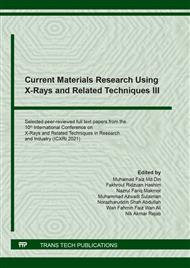[1]
W.H. Gao, K.F. Chen, R.D. Yang, F. Yang, W.J. Han, Properties of bacterial cellulose and its influence on the physical properties of paper, BioResources. 6 (2011) 144–153.
DOI: 10.15376/biores.6.1.144-153
Google Scholar
[2]
V.A. Barbash, O. V. Yashchenko, O.A. Vasylieva, Preparation and application of nanocellulose from Miscanthus × giganteus to improve the quality of paper for bags, SN Appl. Sci. 2 (2020) 1–12.
DOI: 10.1007/s42452-020-2529-2
Google Scholar
[3]
Sunkyu Park, J.O. Baker, M.E. Himmel, P.A. Parilla, D.K. Johnson, Cellulose crystallinity index: measurement techniques and their impact on interpreting cellulase performance, Biotechnol. Biofuels 2010. 3 (2010) 1–10.
DOI: 10.1186/1754-6834-3-10
Google Scholar
[4]
G. Banvillet, G. Depres, N. Belgacem, J. Bras, Alkaline treatment combined with enzymatic hydrolysis for efficient cellulose nanofibrils production, Carbohydr. Polym. 255 (2021).
DOI: 10.1016/j.carbpol.2020.117383
Google Scholar
[5]
M. Asem, D.N. Jimat, N.H.S. Jafri, W.M.F. Wan Nawawi, N.F.M. Azmin, M.F. Abd Wahab, Entangled cellulose nanofibers produced from sugarcane bagasse via alkaline treatment, mild acid hydrolysis assisted with ultrasonication, J. King Saud Univ. Eng. Sci. (2021).
DOI: 10.1016/j.jksues.2021.03.003
Google Scholar
[6]
M. Ioelovich, Cellulose as a nanostructured polymer: A short review, BioResources. 3 (2008) 1403–1418.
DOI: 10.15376/biores.3.4.ioelovich
Google Scholar
[7]
A. Jabbar, J. Hussain, A. Basit, M.S. Naeem, M. Usman, M. Karahan, Influence of Chemical Treatments and Nanocellulose Spray Coating on the Mechanical, Low Velocity Impact and Compression after Impact Performance of Nonwoven Jute Composites Influence of Chemical Treatments and Nanocellulose Spray Coating on the Mechanica, J. Nat. Fibers. 17 (2020) 1785–1797.
DOI: 10.1080/15440478.2019.1598918
Google Scholar
[8]
M. Bouhoute, N. Taarji, L. de Oliveira Felipe, Y. Habibi, I. Kobayashi, M. Zahar, Microfibrillated cellulose from Argania spinosa shells as sustainable solid particles for O/W Pickering emulsions, Carbohydr. Polym. 251 (2021) 116990.
DOI: 10.1016/j.carbpol.2020.116990
Google Scholar
[9]
B. Amalia, C. Imawan, A. Listyarini, Effect of nanofibril cellulose isolated from pineapple leaf on the mechanical properties of chitosan film, AIP Conf. Proc. 2023 (2018).
DOI: 10.1063/1.5064031
Google Scholar
[10]
S. Eartrakulpaiboon, N. Tonanon, Preparation of microcrystalline cellulose from dissolving cellulose by cryo-crushing and acid hydrolysis, IEEE Sens. J. (2015) 188–190.
DOI: 10.1109/ticst.2015.7369359
Google Scholar
[11]
D. Bitounis, G. Pyrgiotakis, D. Bous, P. Demokritou, NanoImpact Dispersion preparation , characterization , and dosimetric analysis of cellulose nano- fi brils and nano-crystals : Implications for cellular toxicological studies, 15 (2019).
DOI: 10.1016/j.impact.2019.100171
Google Scholar
[12]
X. Cao, Y. Wang, H. Chen, J. Hu, L. Cui, Preparation of different morphologies cellulose nanocrystals from waste cotton fibers and its effect on PLLA / PDLA composites films, Compos. Part B. 217 (2021) 108934.
DOI: 10.1016/j.compositesb.2021.108934
Google Scholar
[13]
Y.W. Chen, H.V. Lee, Revalorization of selected municipal solid wastes as new precursors of green,nanocellulose via a novel one-pot isolation system: A source perspective, Int. J. Biol. Macromol. 107 (2018) 78–92.
DOI: 10.1016/j.ijbiomac.2017.08.143
Google Scholar
[14]
E. Fortunati, M. Peltzer, I. Armentano, L. Torre, A. Jiménez, J.M. Kenny, Effects of modified cellulose nanocrystals on the barrier and migration properties of PLA nano-biocomposites, Carbohydr. Polym. 90 (2012) 948–956.
DOI: 10.1016/j.carbpol.2012.06.025
Google Scholar
[15]
A.D. French, M. Santiago Cintrón, Cellulose polymorphy, crystallite size, and the Segal Crystallinity Index, Cellulose. 20 (2013) 583–588.
DOI: 10.1007/s10570-012-9833-y
Google Scholar
[16]
L. Segal, J.J. Creely, A.E. Martin, C.M. Conrad, An Empirical Method for Estimating the Degree of Crystallinity of Native Cellulose Using the X-Ray Diffractometer, Text. Res. J. 29 (1959) 786–794.
DOI: 10.1177/004051755902901003
Google Scholar
[17]
U.U. Zakiyya, M. Masruri, Z. Ningsih, A. Srihardyastutie, Sonication-Assisted pine cone flower cellulose hydrolysis using formic acid, IOP Conf. Ser. Mater. Sci. Eng. 833 (2020).
DOI: 10.1088/1757-899x/833/1/012001
Google Scholar
[18]
Z.D. Nasihin, M. Masruri, W. Warsito, A. Srihardyastutie, Preparation of Nanocellulose Bioplastic with a Gradation Color of Red and Yellow, IOP Conf. Ser. Mater. Sci. Eng. 833 (2020).
DOI: 10.1088/1757-899x/833/1/012078
Google Scholar
[19]
C. Orrabalis, D. Rodríguez, L.G. Pampillo, C. Londoño-Calderón, M. Trinidad, R. Martínez-García, Characterization of nanocellulose obtained from cereus forbesii (a South american cactus), Mater. Res. 22 (2019) 1–10.
DOI: 10.1590/1980-5373-mr-2019-0243
Google Scholar
[20]
C. Vivian Abiaziem, A. Bassey Williams, A. Ibijoke Inegbenebor, C. Theresa Onwordi, C.O. Ehi-Eromosele, L. Felicia Petrik, Preparation and Characterisation of Cellulose Nanocrystal from Sugarcane Peels by XRD, SEM and CP/MAS 13C NMR, J. Phys. Conf. Ser. 1299 (2019).
DOI: 10.1088/1742-6596/1299/1/012123
Google Scholar
[21]
E. Jin, J. Guo, F. Yang, Y. Zhu, J. Song, Y. Jin, On the polymorphic and morphological changes of cellulose nanocrystals (CNC-I) upon mercerization and conversion to CNC-II, Carbohydr. Polym. 143 (2016) 327–335.
DOI: 10.1016/j.carbpol.2016.01.048
Google Scholar
[22]
M. Umashankaran, S. Gopalakrishnan, Characterization of Bio-fiber from Pongamiapinnata L. Bark as Possible Reinforcement of Polymer Composites, J. Nat. Fibers. 18 (2021) 823–833.
DOI: 10.1080/15440478.2019.1658254
Google Scholar
[23]
H. Kurita, R. Ishigami, C. Wu, F. Narita, Experimental Evaluation of Tensile Properties of Epoxy Composites with Added Cellulose Nanofiber Slurry, Strength Mater. 52 (2020) 798–804.
DOI: 10.1007/s11223-020-00233-3
Google Scholar
[24]
R. Kumar, B. Rai, G. Kumar, A Simple Approach for the Synthesis of Cellulose Nanofiber Reinforced Chitosan/PVP Bio Nanocomposite Film for Packaging, J. Polym. Environ. 27 (2019) 2963–2973.
DOI: 10.1007/s10924-019-01588-8
Google Scholar
[25]
B. Zhang, C. Huang, H. Zhao, J. Wang, C. Yin, L. Zhang, Effects of cellulose nanocrystals and cellulose nanofibers on the structure and properties of polyhydroxybutyrate nanocomposites, Polymers (Basel). 11 (2019) 1–21.
DOI: 10.3390/polym11122063
Google Scholar


